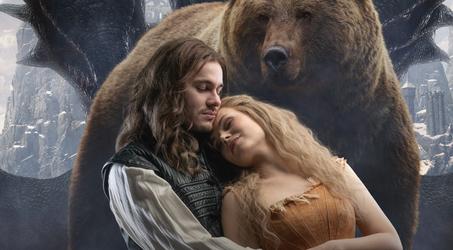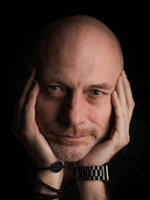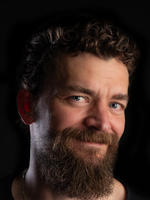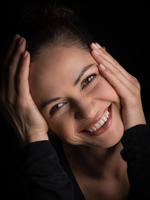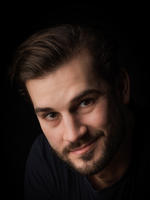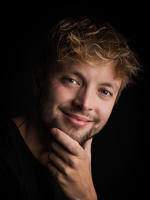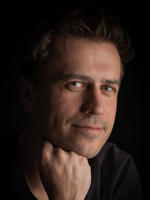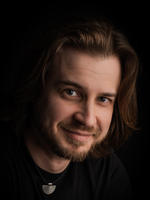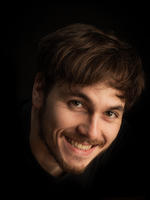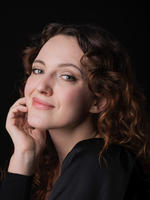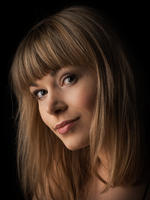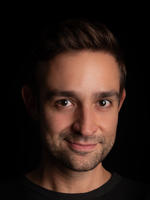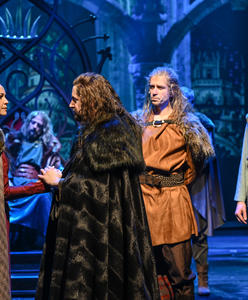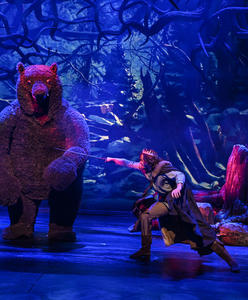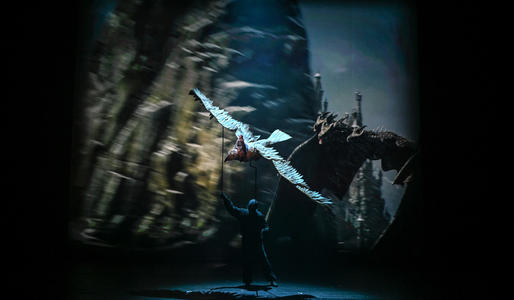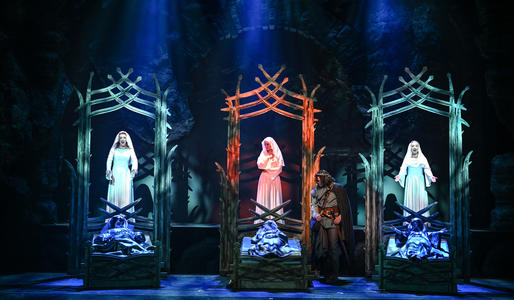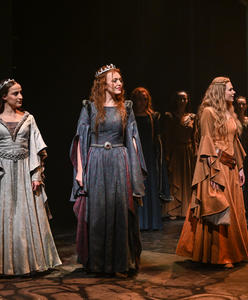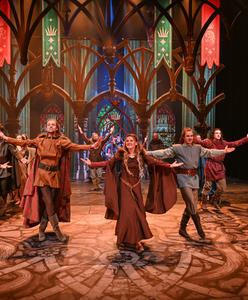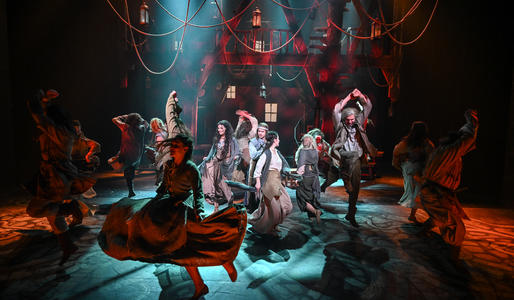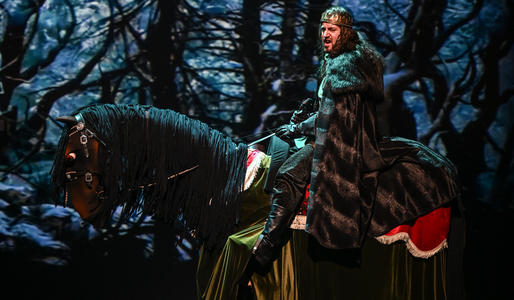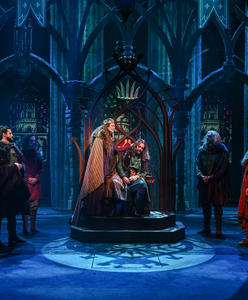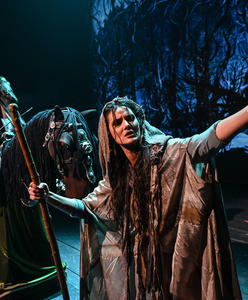The Search for the Fairy-tale Water of Life Is Afoot in Brno
J.P. Kříž 29. January 2025 zdroj Kritikova Žeň (Šeň)
(…) The fairy tale The Water of Life bears a hallmark worthy of the family silver: Zdenek Merta and Stanislav Moša. The list of the musicals and musical numbers they have been responsible for at what is indisputably the best musical theatre in the Czech Republic is a long and unique one. They explore big themes. They refuse to pander to the audience. Their inventiveness is exemplary. And their work on Karel Jaromír Erben’s original fairy tale The Water of Life (published in the programme) is no exception. They have again found a new and distinctive source of inspiration. They and their production team have created another masterpiece in Brno and have added another work to the trove of family silver at Brno City Theatre. One of the greatest contributions has been made by Petr Hloušek, who is responsible for the stage design and the 3D projections which elevate the fantasy world he has brought to life to produce a real fairy-tale experience.
(…) Hloušek has an excellent understanding with Jaroslav Milfajt, who devised the puppets for the fairy tale. He has combined a piece of real life with puppet theatre and has this time conceived an eagle and a bear (rather than Erben’s wolf), a three-headed dragon (instead of the original nineteen-headed one), and a dog for director Moša.
(…) And then there is Andrea Kučerová and her costumes! Different for the umpteenth time, always original, perfect in line, native and foreign, and different in the land of justice and joy and the lands of destitution, villainy and ruin. And we could go on, right up to the segments of film by Dalibor Černák directed by Tomáš Bayer.
(…) The whole piece is, however, dominated by Merta’s musical concept. He elevates the verse libretto to a true theatrical experience. Moša has guided the story towards the comprehensible and the straightforward and a clear contrast between good and evil. As is generally the case with fairy tales, the older members of the audience in particular feel a need to give the game away when good and truth are wronged and a single sentence would be enough for everyone else to understand that people have merely fallen for the scoundrels’ tricks again.
Melody and the ability to convey an idea to the benefit of the story are going out of fashion in musical productions, which now tend to be merely tragically feeble strings of songs. Merta seems to be becoming wiser all the time. His studio produces inventive, communicative, and even memorable melodies.
(…) This is not the place to accentuate any particular acting performances at the expense of the others. The Water of Life is a collective work, and it is often the case at Brno City Theatre that two or even three performers are cast in each role in any given production. (…) But we cannot ignore the fact that there is one name here that is particularly dazzling: Esther Mertová in the role of the youngest cursed princess Kristýna (Erben’s virgin queen). A pure and lyrical voice as clear as a bell, flawless intonation, and extraordinary progress as an actor. A great talent.
(…) And I would like to say a word about the programme. This is something that is rarely written about, it should really be a matter of course, but that is not the case here. Printed programmes accompanying productions, to a high professional standard, exhaustive, readable. This time with a reflection by Eliška Halodová on productions of fairy tales at Brno City Theatre, with a Fairy Tale Quiz, with words from the production team and resumés about them, with plenty of archive photographs and photographs from the production, with Erben’s fairy tale and, it goes without saying, the text of The Water of Life...
A Classic Fairy Tale Straddling Tradition, Verse, Modern Technology and Music
Luboš Mareček 25. January 2025 zdroj www.mestohudby.cz
Brno City Theatre is presenting a new original title on the big stage. The musical The Water of Life is the work of the author of the libretto and director Stanislav Moša, a mainstay of this theatre, who has been working in tandem with composer Zdenek Merta for many years. This is their tenth collaboration here, for which they have returned to the fairy-tale genre (their first fairy tale was The Garden of Miracles in 2004). The result is a narrative title that aims to appeal to both young and adult audiences alike.
The aforementioned duo (…) have put their faith in the Czech fairy-tale tradition and the best that the legacy of Karel Jaromír Erben and Božena Němcová has to offer. It is here that lovers of traditional fairy tales will discover a living source of inspiration and see a story that is actually an artful variation on the classic story as we know it from the versions enjoyed by many generations before us. Although these are old themes and motifs that have appeared in national fairy tales, myths and folklore many times before, this new theatrical production also tries to offer the audience a view of today’s world. The plot is simple. A sick king, his three sons – the princes, and the desire to find the water of life that will put the monarch back on his feet. It goes without saying that the convoluted fairy-tale journey to find the magic cure (though also to find oneself) is accompanied by three cursed princesses, three dreamlike fairies and the same number of mysterious beggars, to say nothing of a giant talking bear and an eagle croaking in human tongue. The authors combine the customary and conventional plot with traditional theatricality in the form of puppets and modern digital technology. It is, in any case, quite a feat to engage children accustomed to daily visual miracles on the screens of their phones and tablets, but they have done so extremely successfully here.
What I liked about the result was the way the author straddles old-world tradition and modern-day optics (and not merely technological). Moša has augmented the story’s certain ancient grandeur with grand and original brushstrokes. The thing is, this fairy tale is written in simple verses. (…) And the most important thing is that these verses bring their own intrinsic artistic value to the piece. They are well suited to musical theatre, since their natural meter is itself reminiscent of music. They combine naturally with Merta’s music, and this now seemingly outdated linguistic air reveals the magical charm of bound speech to young audiences. That is truly commendable...
Merta’s inventive music is not one-dimensional mawkish fairy-tale music, but takes in a number of aspects, from the gently dramatic and symphonic grandeur to what seem like folk songs or rather artful polyphonic songs. The truly lively musical staging by Matěj Voda and Dominik Pernica, who conduct the thirty-piece orchestra behind the stage, is of a high standard elevated by the perfect sound at Brno City Theatre, and also has a dramatic value of its own here, naturally amplifying the audience’s experience of this intense and epic musical show. The large orchestra with a complete string section fills the auditorium with a truly full-bodied sound (in places you can even hear the throb of a rock band) and augments the fairy-tale grandeur of the result. The unreal fairy-tale world and the magic on stage, including the spectacular animated dragon, were created by Petr Hloušek. As I have already noted, Moša’s direction here achieves a perfectly balanced interplay of many digital technologies complemented by the magic of good old puppet theatre. I am referring here to the scenes in which one of the actors leads a puppet of a flying eagle carrying a prince around the empty stage into a large projection in the background, so that the audience gets the impression that the creature on stage flapping the wings of a soaring predator is part of the film image. The seemingly primitive magic of the theatre here not only competes with feats of technology, but also successfully reinforces their magical illusionism. It is pleasant to find that the puppets are equal partners to the live actors here. The adorably stuttering four-metre bear, forever babbling the same syllables, is extremely popular with children! The authors have set the story in visual terms in the winter months in the early Middle Ages, and Andrea Kučerová’s costume workshop has produced as many as 120 costumes in a Gothic style. The painted curtain, in turn, reminds us of the magical drawings of Artuš Scheiner, the court illustrator of Czech fairy tales who also produced honest and charmingly drawn pictures for advertising fairy-tale booklets that were always of an excellent standard. Michal Matěj’s choreography is also an organic part of the production, featuring both large production numbers in a pub and specific movements of the interplaying puppets.
All the roles are played by more than one actor alternating in the individual performances, and there are more than fifty actors performing on stage during the production. Libor Matouš truly shone as the youngest and most honourable prince at the first premiere. Esther Mertová, who is physically and vocally predisposed for this type of role, offered a delicately lyrical, pure and vocally disarming performance as the youngest cursed princess Kristýnka. Other protagonists who also deserve our praise include Tereza Navrátilová, Dagmar Křížová, Ondřej Studénka and Kristian Pekar.
The fairy tale The Water of Life relies in this theatrical package on many traditional motifs, such as magical beasts, tests of courage and loyalty, pure selfless love and, it goes without saying, a happy ending. All this is complemented by modern stage devices. Brno City Theatre has staged a musical fairy tale title that is truly family-friendly: it will astonish viewers of all ages and treat them to a theatrical miracle and magic that will bring the whole family together.
The Water of Life – The Tenth Production from the Creative Team of Moša and Merta
Jaroslav Štěpaník 19. January 2025 zdroj www.brnozurnal.cz
(…) The staging of a Czech fairy tale based on a traditional genre plot with a well-established storyline stereotype is made even more effective by a “contemporary packaging” that makes appropriate use of modern stage devices and approaches with which even young viewers are accustomed today, perhaps even more so than many adults. This technique, which contributes to the flow and dynamics of the plot, is implemented in an interesting fashion in combination with the theatrical tradition – with puppets whose appearance and imaginative technical design catch the attention at first glance. The first thing that catches the audience’s attention is the curtain with its patina of antiquity. At first glance, it evokes the colour prints that used to decorate the front covers of old editions of books of fairy tales.
(…) The audience is quickly engaged in the action and drawn into the plot. The piece has momentum and the individual scenes alternate rapidly with frequent pronounced contrasts. An intimate scene with sad reflections and sorrow about how to help the sick king or how to proceed when help does not arrive is followed by a dynamic scene full of people in motion. A similar contrast reinforces and accelerates the plot as we follow the journey of each of the three princes in search of the water of life. Technical means round out or create the “historical” background and the environment in which the plot is situated and takes place. The interaction with live actors in beautiful historical costumes is natural, compact and harmonious and creates the atmosphere of bygone times. The projections sometimes give the piece an almost cinematic appearance, draw us into the action suggestively, and at times evoke a sense of proximity almost to the point of illusion, as if we were walking through a menacing and dangerous forest with the hero, the youngest of the brothers, and then, as if we were almost sitting next to him soaring into battle with a multi-headed dragon monster on the wings of an eagle. We should also give the commensurate praise here to the people who have lent the puppets their distinctive speech. The imposing eagle, the good-natured bear, the impressively large and interestingly designed horse and the adorable little white dog were certainly popular with the audience.
(…) The music is superb, alternating temperamental and dynamic tones with ones full of hope and emotion, and playing in harmony with the words and the plot. The most impressive is undoubtedly the delicately emotional performance given by Esther Mertová in her solo, in her duet with the youngest of the princes and in her trio with the fairies – Leaf After Leaf Falls into the Water...
(…) Brno City Theatre does not forget its child audience and does not neglect to include family performances in its programme that appeal both to children and their adult companions. These are often proven world “hits”. Here, we must show our appreciation for the idea of bringing an original musical fairy tale based on the treasury of traditional Czech fairy tales to the stage in the form of a musical that makes apposite use of the resources available to a modern theatre. It can be expected from the response and reaction of child and adult members of the audience alike that The Water of Life has appealed to those who have seen it and will continue to appeal to others. It could be interesting to see how a Czech fairy-tale musical would be received by audiences abroad. It would be worth a try.
The Water of Life – Let’s Keep Love in Our Hearts
Josef Meszáros 17. January 2025 zdroj www.scena.cz
Brno City Theatre has staged the world premiere of the fairy-tale musical THE WATER OF LIFE by Zdenek Merta and Stanislav Moša on its Music Stage.
(…) Director Stanislav Moša and his production team have not only seized the classic theme with both hands, but have also shifted it to a new level thanks to their creativity and the theatre’s modern technological facilities. These are not mere embellishments here, but serve the story and the audience’s experience without proving a distraction. This sensitive approach has also been reflected in the actors’ performances and the overall atmosphere of the production. (…) The Water of Life sticks to the fairy-tale tradition and archetypes that we know from Božena Němcová and Karel Jaromír Erben, though the production team have added a number of new elements – Zdenek Merta’s multi-genre music and Stanislav Moša’s rhythmic wordplay. A simple children’s rhyme, for example, acquires new meaning and poetry under Moša’s direction and adds another dimension to the whole production.
(…) Zdenek Merta confirms his reputation as a compositional wizard. His music ranges from medieval rhythms and emotional ballads to rock compositions, jazz and film finales. Each genre is precisely interconnected and supports the story. Conductor Matěj Voda and choirmaster Dominik Pernica put the finishing touches to the musical atmosphere. Set designer Petr Hloušek does outstanding work with projections and three-dimensional backdrops. Forests, castles and the flight of an eagle create a real fairy-tale fantasy. Costume designer Andrea Kučerová has found inspiration in the Gothic and works with a variety of materials. Jaroslav Milfajt’s puppets of an eagle, a bear and a horse are masterful and technically perfect. Libor Matouš as Prince Jan embodies empathy and justice. His gradual infatuation with Princess Kristýna (Esther Mertová) is natural and believable. Ivana Vaňková as Queen Anežka brings a positive energy and depth of emotion. Brothers Jiří (Kristian Pekar) and Jakub (Ondřej Studénka) play their negative roles to brilliant effect, while the princesses Ema, Anna and Kristýna (Tereza Navrátilová, Dagmar Křížová and Esther Mertová) bring an emotional richness and nuances of expression.
The Water of Life is not just about the healing of King David, but also about the search for justice, love and kindness within ourselves. It is a story that reminds us that the greatest source of living water is in our own hearts. Let us keep them filled with love and kindness.

